An integrated approach to cost-effective manufacturing of
An integrated approach to cost-effective manufacturing of
An integrated approach to cost-effective manufacturing of
You also want an ePaper? Increase the reach of your titles
YUMPU automatically turns print PDFs into web optimized ePapers that Google loves.
Abstract<br />
<strong>An</strong> Integrated Cost-Effective Approach <strong>to</strong> Blisk Manufacturing<br />
This paper describes an <strong>approach</strong> <strong>to</strong> technically/commercially<br />
optimized blisk <strong>manufacturing</strong><br />
that integrates design and <strong>manufacturing</strong> technologies.<br />
The use <strong>of</strong> optimized <strong>manufacturing</strong> process chains<br />
and design-<strong>to</strong>-<strong>cost</strong> <strong>approach</strong>es enables significant<br />
<strong>cost</strong>-savings <strong>to</strong> be achieved.<br />
Abbreviations<br />
ECM Electrochemical Machining<br />
PECM Precise Electrochemical Machining<br />
HSC High Speed Cutting<br />
Blisk Bladed <strong>integrated</strong> Disk<br />
IBR Integrated Bladed Ro<strong>to</strong>r<br />
LFS Linear Friction Welding<br />
IHFP Inductive High Frequency Pressure-<br />
Welding<br />
LPC Low pressure Compressor<br />
HPC High pressure Compressor<br />
AM Adaptive Milling<br />
CP Chemical Polishing<br />
NDT None Destructive Testing<br />
1 Introduction<br />
Blisks (bladed <strong>integrated</strong> disks), or IBRs (bladed<br />
<strong>integrated</strong> ro<strong>to</strong>rs), are among the most innovative and<br />
challenging components in modern gas turbine engines<br />
(Fig 1). Initially used in small helicopter engines,<br />
blisks soon invaded the military engine field<br />
and are now carving out new terri<strong>to</strong>ry in the commercial<br />
turb<strong>of</strong>an (e.g. PW6000) and turboprop engine<br />
(e.g. TP400 D6) markets and replace the conventional<br />
blade assembled disk (Fig. 2).<br />
Blisk technology is finding use notably when requirements<br />
for high compressor power density need<br />
<strong>to</strong> be harmonized with demands for maximum engine<br />
thrust-<strong>to</strong>-weight ratio [1, 2].<br />
Martin Bußmann & Dr. Jürgen Kraus & Dr. Erwin Bayer<br />
MTU Aero Engines, Munich, Germany<br />
1<br />
ISABE 2005<br />
Fig. 1: LPC 1-3 in blisk construction (EJ200)<br />
Fig. 2: LPC separate blades and disk (J79)<br />
Speaking for the use <strong>of</strong> blisks essentially is that they<br />
reduce weight by as much as 20% and significantly<br />
improve efficiency, compared with their separably<br />
assembled blade-and-disk counterparts, and that they<br />
so help reduce fuel consumption and emissions. If<br />
further <strong>integrated</strong>, as in<strong>to</strong> welded blisk drums or tandem<br />
blisks, they will again enhance compactness and<br />
weight savings.
%<br />
%<br />
120<br />
100<br />
80<br />
60<br />
40<br />
20<br />
0<br />
120<br />
100<br />
80<br />
60<br />
40<br />
20<br />
0<br />
Fig. 3 Blisk forecast 2001 – 2020<br />
As can be readily appreciated, the weight savings<br />
afforded by blisks result from their lower rim loads,<br />
blade roots and disk lugs being eliminated, and from<br />
the fact that they allow more performance <strong>to</strong> be<br />
squeezed in<strong>to</strong> the same design and weight envelope.<br />
The blisk construction also mitigates aerodynamic<br />
losses by reducing leakage flows.<br />
A forecast for the development <strong>of</strong> the blisk market is<br />
shown in Fig. 3. There will be a distinct increase in<br />
produced Blisk within the next years.<br />
Presently, these advantages still compare with disadvantages<br />
like the laborious <strong>manufacturing</strong> and repair<br />
processes and elaborate quality assurance measures<br />
that blisks require and that primarily reflect in relatively<br />
high <strong>manufacturing</strong> and repair <strong>cost</strong>s.<br />
Among other drawbacks, the direct blade-<strong>to</strong>-disk joint<br />
comes with a locally stiffened fillet radius which<br />
appreciably narrows the <strong>to</strong>lerance <strong>of</strong> dimensional<br />
deviations at the airfoil [2]. To precisely generate<br />
complex 3D airfoil geometries with fillet radii reaching<br />
in<strong>to</strong> the disk body imposes <strong>to</strong>ugh challenges for<br />
<strong>manufacturing</strong> machines and <strong>to</strong>ols and, moreover, the<br />
entire CAX chain.<br />
Also, compared with conventional repairs on individual<br />
blades, repairs on blisk airfoils are more difficult<br />
<strong>to</strong> perform since repair processes must not be allowed<br />
Blisk forecast 2001 - 2020<br />
2001-2005 2006-2010 2011-2015<br />
Year<br />
2016-2020 Sum<br />
Blisk forecast - Main Airfoiling Processes<br />
2001-2005 2006-2010 2011-2015<br />
Year<br />
2016-2020 Sum<br />
2<br />
mil. EU<br />
mil. USA<br />
Civil Blisk<br />
ECM<br />
HSC<br />
Jo in in g<br />
<strong>to</strong> negatively affect the disk body, and accessibility is<br />
a problem, <strong>to</strong>o.<br />
2 Motivation<br />
As performance requirements for modern engines<br />
grow but the design and weight envelope remains the<br />
same or is even narrowed, stage loads and compression<br />
ratios necessarily grow along with them and<br />
service temperatures generally rise. This calls for the<br />
use <strong>of</strong> blisk constructions and, in the aft stages <strong>of</strong> the<br />
high-pressure compressor, <strong>of</strong> (heavier) nickel-base<br />
alloys, again in the weight-conscious blisk construction,<br />
which in turn compels the development <strong>of</strong> <strong>cost</strong>efficient<br />
machining processes <strong>to</strong> cope with these<br />
difficult-<strong>to</strong>-machine materials.<br />
As service temperatures keep rising, temperature<br />
gradients at the airfoil-<strong>to</strong>-disk transition tend <strong>to</strong> induce<br />
high, no longer manageable local stresses. This<br />
is where blisks are presently bumping in<strong>to</strong> utility<br />
limits and engineers will likely have <strong>to</strong> revert <strong>to</strong> conventional,<br />
separably assembled ro<strong>to</strong>r stages. This<br />
indicates a need <strong>to</strong> develop cooled hollow-blade<br />
blisks.<br />
To foster cus<strong>to</strong>mer acceptance <strong>of</strong> blisk constructions,<br />
development efforts have been initiated in an attempt<br />
<strong>to</strong> reduce blisk <strong>manufacturing</strong> <strong>cost</strong>s. Since these are<br />
still appreciably higher than for separably assembled<br />
blade-<strong>to</strong>-disk joints, it will not be sufficient <strong>to</strong> optimize<br />
individual <strong>manufacturing</strong> steps. Rather, a de-
sign-based <strong>integrated</strong> <strong>approach</strong> is needed that involves<br />
the entire process chain from material selection<br />
<strong>to</strong> <strong>manufacturing</strong> and repair.<br />
Blisk <strong>manufacturing</strong> <strong>cost</strong>s roughly break down in<strong>to</strong><br />
three nearly equal wedges; one third being material<br />
<strong>cost</strong>s, another third airfoiling, and the last third disk<br />
machining and quality assurance.<br />
Materia<br />
l<br />
30%<br />
Airfoilin<br />
g<br />
30%<br />
Fig. 4 Blisk main <strong>cost</strong><br />
Machining,<br />
Quality<br />
assurance<br />
&…<br />
In a <strong>cost</strong>-cutting <strong>integrated</strong> process chain <strong>approach</strong>,<br />
activities need <strong>to</strong> be defined for all three <strong>cost</strong> wedges.<br />
Apart from indirectly influencing the <strong>cost</strong>s <strong>of</strong> raw<br />
materials or semifinished parts through material selection<br />
and design, and directly influencing <strong>manufacturing</strong><br />
<strong>cost</strong>s through these disciplines, most likely<br />
candidates for direct <strong>manufacturing</strong> <strong>cost</strong> reduction are<br />
airfoiling and quality assurance.<br />
In these deliberations, engineers are increasingly<br />
recognizing that there is no such thing as an optimum<br />
<strong>manufacturing</strong> process, especially not for airfoiling.<br />
Which process is best-suited, technically / commercially,<br />
rather depends on a variety <strong>of</strong> geometric and<br />
material-related parameters.<br />
Technology and<br />
Predesign<br />
Technology Projects<br />
New Constructions<br />
Production and QS-<br />
Technologies<br />
Innovative Production<br />
and QS- Technologies<br />
Performance<br />
Engine Cycle<br />
Materialtechnology<br />
Material Design<br />
Damage <strong>An</strong>alysis<br />
Aerodynamics<br />
Efficiency<br />
Surge Margin<br />
Noise<br />
↔<br />
Engineering Support<br />
CAD, EDM<br />
Standardisation<br />
Documentation<br />
3<br />
3 Design-<strong>to</strong>-<strong>cost</strong> as an integral part <strong>of</strong> the<br />
process chain<br />
The relentlessly mounting <strong>cost</strong> pressure on turbine<br />
engine components these past several years has led <strong>to</strong><br />
a change in paradigms in development departments<br />
worldwide. If in earlier days, the emphasis clearly<br />
used <strong>to</strong> be on performance and aerodynamics, along<br />
with accordingly stringent component quality requirements,<br />
entirely novel processes with shifted<br />
priorities have since won the day. Where development<br />
requirements once were unconditionally implemented<br />
on the shop floor, <strong>manufacturing</strong> and development<br />
goals <strong>to</strong>day are now assessed both technically<br />
and commercially and implemented for optimum<br />
compliance with specifications. Fig. 5 illustrates the<br />
process steps unfolding within development. Design<br />
engineering here serves an integrating function across<br />
all disciplines and therefore constitutes the interface<br />
with <strong>manufacturing</strong>.<br />
In component design, the simulation and assessment<br />
<strong>of</strong> <strong>manufacturing</strong> processes has since become a crucial<br />
<strong>cost</strong> containment <strong>to</strong>ol. This is illustrated below by<br />
way <strong>of</strong> several typical cases.<br />
3.1 Optimization <strong>of</strong> annulus <strong>manufacturing</strong><br />
<strong>cost</strong>s<br />
For blisk blade <strong>manufacturing</strong>, three different techniques<br />
are presently available: milling the entire airfoil<br />
from the solid for mid- and small-size blades;<br />
joining blade and disk <strong>to</strong>gether by linear friction<br />
welding for large blades, with subsequent adaptive<br />
milling <strong>of</strong> the transitional area; and using electrochemical<br />
material removal processes. In the first two<br />
cases, the gas duct area between the airfoils is milled.<br />
At this point, considerable <strong>cost</strong> savings can be<br />
achieved by adapting the aerodynamic surface finish<br />
requirements <strong>to</strong> the <strong>manufacturing</strong> process. For the<br />
purpose, the following procedure has become accepted<br />
practice:<br />
Process Chain<br />
Development<br />
Input Manufacturing<br />
Design<br />
Design Integration<br />
Producibility<br />
Mountability<br />
Fig.5: Development Process Chain<br />
Structural Mechanics<br />
Ro<strong>to</strong>r Dynamics<br />
Component Integrity<br />
Life Management<br />
SAS and Oilsystem<br />
Cooling Air Supply<br />
Lubricant Supply<br />
Sealing Systems<br />
Thermal Mechanics<br />
Temperatures<br />
Cooling Systems
The <strong>manufacturing</strong> department, through simulation<br />
<strong>of</strong> the finish milling process, specifies the number,<br />
lay and height <strong>of</strong> milling crests that would have <strong>to</strong><br />
be <strong>to</strong>lerated on the finished part <strong>to</strong> make the design<br />
<strong>cost</strong>-efficient. In this, one <strong>of</strong> the key constraints is<br />
the specified airfoil-<strong>to</strong>-annulus fillet radius, which<br />
from <strong>cost</strong> aspects should be held as wide as possible.<br />
The design engineers then translate these specifications<br />
in<strong>to</strong> CAD models <strong>to</strong> be assessed by the structural<br />
mechanics and aerodynamics departments, for<br />
which see Fig. 6 - 7.<br />
For structural mechanics purposes, the assessment<br />
criteria here is the severity <strong>of</strong> stress concentrations,<br />
and assurance must be provided that after subsequent<br />
etch and compaction peening processes, inspectability<br />
is preserved, or that no crimped material<br />
(elephant tails) will occur at the edges. Aerodynamically,<br />
assurance must be provided that through the<br />
milling crests, no additional in<strong>to</strong>lerable losses will<br />
occur from flow separation or secondary flow. Final<br />
definition <strong>of</strong> <strong>to</strong>lerable crest geometry is usually<br />
achieved by iterative process.<br />
Fig. 6: Representation <strong>of</strong> annulus milling crests<br />
Fig 7: Milling crests in the annulus area<br />
4<br />
3.2 Optimization <strong>of</strong> surface-related airfoil<br />
<strong>manufacturing</strong> <strong>cost</strong>s<br />
The picture is much the same regarding surface<br />
finish requirements for the airfoil, although the<br />
aerodynamic effects <strong>to</strong> be considered here are notably<br />
more critical. Coming out <strong>of</strong> the milling operation,<br />
the airfoil still exhibits various form errors that<br />
may give rise <strong>to</strong> considerable losses, for which see<br />
Fig. 8. Apart from roughness, these are the height<br />
and spacing <strong>of</strong> milling crests and the lay <strong>of</strong> milling<br />
crests relative <strong>to</strong> the main flow. The aerodynamics<br />
department, in keeping with specification requirements<br />
(overall efficiency, surge limit), computes the<br />
major <strong>manufacturing</strong> requirements, such as blade<br />
count, roughness, allowable milling lines remaining<br />
from milling operations after surface finishing, <strong>to</strong>lerance<br />
bands for stripe milling, etc. The <strong>manufacturing</strong><br />
department uses this data <strong>to</strong> define the necessary<br />
milling parameters and surface finish methods <strong>to</strong> use<br />
(vibra<strong>to</strong>ry grinding with and without chemical additions).<br />
The aim should be <strong>to</strong> generate the milling<br />
surfaces preferably so that they do not require subsequent<br />
manual surface finishing. If after this first<br />
iteration, the process is not yet within target <strong>cost</strong>s,<br />
the <strong>manufacturing</strong> department develops <strong>cost</strong> reduction<br />
proposals for renewed assessment. Typically,<br />
such proposals relate <strong>to</strong> widening the fillet radius<br />
and raising the residual milling crest <strong>to</strong>lerance or<br />
roughness.<br />
Fig. 8: Typical scoring texture on airfoil after finish<br />
milling and before grinding<br />
3.3 Optimization <strong>of</strong> airfoil <strong>to</strong>lerances<br />
As previously mentioned, the direct blade-<strong>to</strong>-disk<br />
joint increases stiffness and may lead <strong>to</strong> stress concentrations<br />
at the fillet radius if deviations from
allowable <strong>to</strong>lerances exist. This is caused by a displacement<br />
<strong>of</strong> the airfoil center <strong>of</strong> gravity. Involved<br />
are con<strong>to</strong>ur, angular and airfoil thickness <strong>to</strong>lerances,<br />
fillet radius <strong>to</strong>lerance and those <strong>to</strong>lerances that define<br />
the orientation <strong>of</strong> the stacking line. Extreme<br />
positions <strong>of</strong> these parameters within the <strong>to</strong>lerance<br />
band will not by themselves jeopardize the structural<br />
integrity <strong>of</strong> the blisk. However, critical situations<br />
may arise from unfavorable <strong>to</strong>lerance combinations,<br />
e.g. when the fillet radius was machined <strong>to</strong> minimum<br />
value and the airfoil thickness is a minimum at<br />
the inner annulus and a maximum at the blade tip.<br />
The occurrence <strong>of</strong> such combinations naturally is<br />
rather unlikely, but must not be dismissed from<br />
consideration. Attempts <strong>to</strong> narrow the <strong>to</strong>lerance<br />
bands <strong>to</strong> a point where also these special cases are<br />
covered would result in extremely high <strong>manufacturing</strong><br />
<strong>cost</strong>s.<br />
Therefore, reasonable alternative <strong>approach</strong>es need <strong>to</strong><br />
be developed and are indeed being explored in ongoing<br />
projects. The aim is <strong>to</strong> strike a balance between<br />
<strong>cost</strong>-conscious blade <strong>manufacturing</strong> and warranted<br />
quality assurance <strong>cost</strong>s. In the future, probabilistic<br />
methods will be used <strong>to</strong> determine optimized <strong>to</strong>lerance<br />
limits. Probabilistic evaluation will invariably<br />
base on a deterministic model, such as a parameterized<br />
structural mechanical FE model that describes<br />
the interdependency <strong>of</strong> the various variables. Monte<br />
Carlo simulation can be used <strong>to</strong> vary the parameters<br />
at random and adequately minimize the probability<br />
<strong>of</strong> critical <strong>to</strong>lerance combinations.<br />
The difficulty embarrassing this <strong>approach</strong> is that it<br />
assumes the <strong>manufacturing</strong> distribution <strong>to</strong> be known.<br />
Therefore, when the blisk is redesigned, resort must<br />
be made <strong>to</strong> existing data, which involves a relatively<br />
great deal <strong>of</strong> uncertainty. For that reason, quality<br />
assurance plays an important role in minimizing the<br />
remaining risk. However, the classical <strong>approach</strong> <strong>to</strong><br />
mapping airfoil geometries presently<br />
Ni-<br />
Blis<br />
Ti -<br />
Blis<br />
Preparation<br />
airfoiling<br />
core airfoiling<br />
rough machining finishing<br />
LRS LFW /<br />
EC HS LRS LFW /<br />
IHFP<br />
EC ECM / HS IHFP +<br />
AM<br />
X X<br />
X X<br />
X X<br />
: : : : : :<br />
X<br />
X X<br />
5<br />
still resorts <strong>to</strong> coordinate measuring techniques,<br />
which are very time-consuming and can be used<br />
only locally and partially. It represents, therefore, no<br />
<strong>cost</strong>-<strong>effective</strong> solution for mapping complete airfoils.<br />
Accordingly, efforts are made <strong>to</strong> press ahead<br />
with the adoption <strong>of</strong> optical measuring methods,<br />
which <strong>to</strong>day provide adequate accuracy and short<br />
measuring times for the purpose. This measuring<br />
technology permits the 100% inspection <strong>of</strong> all airfoils<br />
in a <strong>cost</strong>-<strong>effective</strong> manner. To assess nonconformities,<br />
the data can be played back, by reverse<br />
engineering, in<strong>to</strong> the development department,<br />
where judicious component lifing decisions can be<br />
made as required.<br />
4 Toolbox <strong>approach</strong> as a component <strong>of</strong><br />
process chain generation<br />
As previously mentioned, the technically / commercially<br />
optimum blisk <strong>manufacturing</strong> process depends<br />
on a plurality <strong>of</strong> material, geometric and aerodynamic<br />
parameters. The <strong>to</strong>olbox <strong>approach</strong> is an attempt<br />
<strong>to</strong> provide the optimum <strong>manufacturing</strong> technology<br />
or combination <strong>of</strong> technologies for all current<br />
and anticipated requirements.<br />
This <strong>approach</strong> essentially comes in<strong>to</strong> play at the time<br />
<strong>of</strong> airfoiling, with differentiation being made between<br />
generating a rough geometry with machining<br />
allowance, machining <strong>to</strong> final drawing dimension<br />
and surface finishing.<br />
For processing the disk body, which essentially<br />
involves conventional cutting, surface compaction<br />
and finishing processes, decades <strong>of</strong> experience have<br />
been accumulated on the conventional blade-<strong>to</strong>-disk<br />
construction. It is only in the case <strong>of</strong> joined blisks<br />
(blades welded in<strong>to</strong> place) that several technically /<br />
commercially optimum variants for generating the<br />
preliminary stages need <strong>to</strong> be considered.<br />
Fig 9: Schematic arrangement <strong>of</strong> a blisk <strong>to</strong>olbox for<br />
production<br />
X<br />
Surfac -<br />
treatmen<br />
CU Grinding,<br />
etc.<br />
-<br />
treatmen<br />
CU Grinding,<br />
etc.<br />
X<br />
X<br />
X<br />
: :<br />
: : : : :<br />
: : :<br />
: : : : : : :<br />
: : :<br />
:<br />
: : : : : :<br />
: :<br />
:<br />
X<br />
Surface<br />
finishing, finishing,<br />
ND
Material properties<br />
4.1 Core airfoiling processes<br />
The core airfoiling processes break down in<strong>to</strong> three<br />
major categories (Fig.10):<br />
• joining processes<br />
• cutting processes<br />
• electrochemical processes<br />
ECM ECM / / PECM<br />
PECM<br />
HSC<br />
current<br />
Blisk spectrum<br />
Blade aspect ratio<br />
Fig. 10; Core airfoiling processes for blisk<br />
4.1.1 Joining processes<br />
LFW / IHFP<br />
Linear friction welding (LFW)<br />
Inductive high-frequency pressure welding (IHFP)<br />
These processes refer <strong>to</strong> joining the airfoil with the<br />
disk by means <strong>of</strong> pressure or friction welding processes.<br />
Fig. 11: Linear friction welding (LFW) (joining<br />
zone)<br />
6<br />
In LFW, the joining zone is heated by rubbing the<br />
joining faces one against the other; in IHFP welding,<br />
by means <strong>of</strong> induction. Material is expelled from the<br />
joining zone and after a predetermined reduction in<br />
length, the energy supply is halted and the joined<br />
parts are allowed <strong>to</strong> cool under post-forging pressure.<br />
The expelled material and material allowance are<br />
removed by adaptive rework process.<br />
Fig. 12 Inductive high-frequency pressure (IHFP)<br />
welding (diagrammatic sketch)<br />
The <strong>approach</strong> is used primarily on large-diameter<br />
blisks, hollow-blade blisks and blisks <strong>of</strong> large chamber<br />
volumes and low blade count, or when blades are<br />
replaced by way <strong>of</strong> repair, where also generative<br />
processes like laser cladding may be options.<br />
From these constraints, the use <strong>of</strong> the <strong>approach</strong>—<br />
apart from repair work—is indicated primarily on<br />
titanium blisks in the engine's LPC section.<br />
4.1.2 Cutting processes - High Speed Cutting<br />
(HSC)<br />
This refers <strong>to</strong> cutting processes used <strong>to</strong> manufacture<br />
airfoils on 5- or 6-axis machine <strong>to</strong>ols (Fig. 13), with<br />
differentiation being made between rough and finish<br />
cutting.<br />
Typical processes <strong>of</strong> the kind are circular stagger<br />
milling in conjunction with high-performance <strong>to</strong>ols<br />
and high-pressure internal cooling for the rough cut,<br />
and stripe or flank milling, etc., for the finish cut.
Fig. 13: Blisk milling on a 5-axis machine<br />
In an attempt <strong>to</strong> achieve maximally high material<br />
removal rates in the roughing process, several rough<br />
milling strategies have been developed. In conventional<br />
milling, the space between blades is cleared<br />
gradually by cutting ever deeper in<strong>to</strong> the full section.<br />
<strong>An</strong> alternative process would be circular stagger milling<br />
[Fig. 14], where the cutter center is guided<br />
through the space in-between blades on a trochoid<br />
fitted <strong>to</strong> the airfoil con<strong>to</strong>ur. In flow-wise milling,<br />
plunge cutting is used <strong>to</strong> remove a preferably large<br />
amount <strong>of</strong> material from the blade gap in the direction<br />
<strong>of</strong> flow.<br />
Fig 14: Circular ‘Stagger Milling /<br />
Conventional rough milling<br />
Circular<br />
Stagger<br />
Milling<br />
Conventional<br />
rough<br />
milling<br />
For finish milling <strong>to</strong> generate the final con<strong>to</strong>ur, <strong>to</strong>o,<br />
various milling strategies have been developed <strong>to</strong><br />
produce a 3D con<strong>to</strong>ur. The most common practice is<br />
point milling using a ball-end cutter. Alternatively,<br />
use is made <strong>of</strong> stripe or flank milling.<br />
7<br />
The new milling strategies are made possible by the<br />
use <strong>of</strong> highly dynamic multiaxis machines. Tool lives<br />
have been significantly extended using high-pressure<br />
cooling and novel milling cutter geometries.<br />
These processes are used primarily on mediumdiameter<br />
blisks and medium blade counts, which puts<br />
applications for titanium blisks in the LPC/IPC section.<br />
4.1.3 Electrochemical machining (ECM)<br />
processes<br />
These processes serve <strong>to</strong> generate blade geometries<br />
by electrochemically removing material or selectively<br />
generating airfoil surface textures.<br />
Typical processes <strong>of</strong> the kind are electrochemical<br />
machining (ECM) for caving or precon<strong>to</strong>uring, and<br />
precise electrochemical machining (PECM) for generating<br />
the finished con<strong>to</strong>ur or selectively generating<br />
surface textures.<br />
In ECM work (Fig. 15,16), an electrode (cathode) is<br />
moved <strong>to</strong>ward the workpiece. <strong>An</strong> electrolyte flows<br />
though the gap between the workpiece and electrode<br />
(~ 1mm). The electrode replicates its shape in the<br />
workpiece, with some minor variations. The feed rate<br />
is approximately 2 mm per minute.<br />
Fig 15: ECM blisk<br />
Fig. 16: ECM facility for blisk airfoils<br />
The PECM process (Fig. 17) is an improved ECM<br />
technique, with the gap between workpiece and cathode<br />
appreciably reduced and the size <strong>of</strong> the gap controlled.<br />
This much improves the electrode mapping
accuracy but slows the material removal rate compared<br />
with ECM. To keep the electrolyte renewal<br />
flow going in the narrow gap, the electrode is made <strong>to</strong><br />
vibrate, the current flow being clocked.<br />
These processes are used primarily for medium- <strong>to</strong><br />
small-diameter blisks, high blade counts and high<br />
operating temperatures; hence for blisks in nickelalloy<br />
/ nickel powder metallic materials in the HPC<br />
area.<br />
Fig. 17: Experimental single-axis PECM facility<br />
The individual application <strong>of</strong> a technically / commercially<br />
meaningful combination <strong>of</strong> these technologies<br />
as a building block in the process chain design will<br />
achieve substantial, 20-25% <strong>cost</strong> reductions in airfoiling.<br />
This is illustrated below:<br />
The thermal load on a titanium HPC blisk may be<br />
close <strong>to</strong> allowable limits. Therefore a highly heatresistant<br />
forging alloy <strong>of</strong> adequate HCF strength for<br />
the airfoil should be welded <strong>to</strong> an equally highly heatresistant<br />
forging alloy <strong>of</strong> adequate LCF fatigue<br />
strength for the hub. A suitable joining process for the<br />
purpose would be IHFP welding. To minimize the<br />
airfoil preforging effort, it would be helpful <strong>to</strong> weld<br />
blades with machining allowance <strong>to</strong> the disk. The<br />
allowance material can then be removed by a cutting<br />
or combined ECM/PECM process. This is where the<br />
decision between milling and electrochemical material<br />
removal will depend, apart from price, also on the<br />
stiffness <strong>of</strong> the blades. While during milling, deflection<br />
forces will invariably have <strong>to</strong> be expected, they<br />
average out when simultaneously machining pressure<br />
and suction sides by PECM.<br />
To reduce the quality assurance wedge <strong>of</strong> overall<br />
<strong>cost</strong>s, resort must be made along the <strong>manufacturing</strong><br />
8<br />
chain <strong>to</strong> combinations <strong>of</strong> various quality assurance<br />
<strong>to</strong>ols and new metrological developments. Owing <strong>to</strong><br />
the high criticality <strong>of</strong> blisks in the engine, methods <strong>to</strong><br />
reduce <strong>manufacturing</strong> effort, such as SPC methods,<br />
can be used only conditionally and if so, only as a<br />
concomitant <strong>to</strong> quality assurance. Conceivable <strong>cost</strong>reduction<br />
options, apart from stable <strong>manufacturing</strong><br />
processes, would appear <strong>to</strong> be mainly close-<strong>to</strong>process<br />
or in-process measurement and concurrent<br />
updating <strong>of</strong> qualified <strong>manufacturing</strong> staff on critical<br />
process trends. Promising additional, approximately<br />
30% savings potential is the use <strong>of</strong> innovative optical<br />
blisk mapping techniques in preference <strong>to</strong> contacting<br />
methods.<br />
5 Blisk repair<br />
While in the <strong>manufacturing</strong> <strong>of</strong> blisks a <strong>manufacturing</strong><br />
chain individually optimized <strong>to</strong> suit the particular<br />
type <strong>of</strong> blisk involved seems indicated, (airfoil) repair<br />
considerations tend <strong>to</strong>ward a universally applicable<br />
repair method that lends itself <strong>to</strong> a high degree <strong>of</strong><br />
standardization and, <strong>to</strong> some degree, au<strong>to</strong>mation.<br />
Apart from the relatively simple blending <strong>of</strong> minor<br />
airfoil flaws by grinding or milling and the cladding<br />
<strong>of</strong> blade leading and trailing edges and tips, the development<br />
<strong>of</strong> a universally applicable joining technique<br />
<strong>to</strong> use in the replacement <strong>of</strong> blades, with subsequent<br />
adaptive con<strong>to</strong>ur dressing or generative techniques<br />
(such as laser cladding <strong>to</strong> build up the blade)<br />
seems indicated.<br />
6 Generation <strong>of</strong> optimized blisk <strong>manufacturing</strong><br />
process chains<br />
To be able <strong>to</strong> generate a technically / commercially<br />
optimized <strong>manufacturing</strong> process chain for a certain<br />
blisk type, several different aspects need validating<br />
and optimizing. The methods and <strong>approach</strong>es described<br />
in chapters 3) and 4) provide the major requirements<br />
<strong>to</strong> govern this generation process.<br />
This <strong>approach</strong> closely meshes design engineering and<br />
<strong>manufacturing</strong> technology development and moreover<br />
differs from legacy <strong>approach</strong>es primarily in that it<br />
also anticipates <strong>manufacturing</strong> technologies still in<br />
their planning or implementation phases. It so reflects<br />
the extremely long program lives <strong>of</strong> 20 years and<br />
more common in the engine industry (Fig 18).<br />
Picking up on the engineering constraints, the <strong>approach</strong><br />
first identifies applicable technologies. The<br />
choice is made easier by the use <strong>of</strong> process catalogs<br />
highlighting the properties and limitations <strong>of</strong> the<br />
major processes. Combinational <strong>to</strong>ols are then used <strong>to</strong><br />
piece <strong>to</strong>gether conceivable, generally applicable process<br />
chain combinations and distill them using techni-
cal/commercial filter criteria. Surviving variants will<br />
then be evaluated in-depth.<br />
The advantage afforded by this <strong>approach</strong> is that for<br />
each component type, all conceivable <strong>manufacturing</strong><br />
chains are considered and assessed from scratch.<br />
Net present value calculation considers the time base<br />
<strong>of</strong> the associated engine programs. It will show which<br />
selected variants are optimal also against the background<br />
<strong>of</strong> fluctuating annual quantities, long program<br />
lives and a conceivable development risk in production<br />
engineering. For this process step, the reliability<br />
<strong>of</strong> market numbers and forecasts is a crucial fac<strong>to</strong>r.<br />
The outcome, apart from the currently optimum<br />
<strong>manufacturing</strong> process chain, simultaneously constitutes<br />
a technology roadmap indicating which novel<br />
<strong>manufacturing</strong> technology will have <strong>to</strong> be ready for<br />
production use by what point in time—also after<br />
program launch—<strong>to</strong> still achieve a significant commercially<br />
<strong>effective</strong> impact for the respective engine<br />
programs/blisk types.<br />
At MTU, the method here presented is currently finding<br />
use for blisks. Generally, however, it should be<br />
suitable also for other engine components whenever<br />
base value, criticality and individuality in respect <strong>of</strong><br />
potential <strong>manufacturing</strong> variants warrant the effort.<br />
input design,…<br />
Data Acquisition<br />
- current situation -<br />
• drawings<br />
• pre-calculation<br />
•etc.<br />
Next Steps:<br />
• determination R & D<br />
• quotation <strong>cost</strong>ing<br />
input engineering<br />
Core Technologies<br />
Milling <br />
ECM <br />
PECM <br />
…<br />
Optimal<br />
Process Chain<br />
Rohmaterial<br />
ProzessschrittPS<br />
1<br />
ProzessschrittPS<br />
...<br />
ProzessschrittPS<br />
2<br />
ProzessschrittPS<br />
n<br />
Fig. 18: Process Chain Manufacturing<br />
input engineering<br />
General Technology<br />
Combinations<br />
Net Present Value<br />
Kapitalwert [T€]<br />
300,0<br />
200,0<br />
100,0<br />
0,0<br />
0% 10% 20% 30% 40%<br />
techn. Risiko<br />
9<br />
7 Summary<br />
To cope with the mounting <strong>cost</strong> pressure in the engine<br />
sec<strong>to</strong>r and still be able <strong>to</strong> achieve significant leaps<br />
forward in technology innovation, it will be imperative<br />
<strong>to</strong> mesh the engineering disciplines with each<br />
other.<br />
Particularly for high-value components like blisks<br />
with their stringent quality requirements, competitive<br />
prices can be achieved only if the entire <strong>manufacturing</strong><br />
chain including design and technology development<br />
is systematically optimized. This increasingly<br />
requires an iterative interdisciplinary strategy rather<br />
than the usually practiced sequential <strong>approach</strong>.<br />
Importantly, also various <strong>manufacturing</strong> chains and<br />
technologies should be provided <strong>to</strong> choose from so<br />
that the ones optimally suited <strong>to</strong> the respective type <strong>of</strong><br />
blisk under manufacture can be selected.<br />
References<br />
[1] Geidel, H.-A.: Blisk-Technologie hilft<br />
sparen. AeroSpace – Magazine <strong>of</strong> the Daimler-Benz<br />
Aerospace AG, 1997<br />
[2] Kosing, O.E.; Scharl, R.; Schmuhl, H.J.:<br />
Design Improvements <strong>of</strong> the EJ200 HP<br />
Compressor. From Design Verification Engine<br />
<strong>to</strong> a Future all Blisk Version. ASME-<br />
Pap-2001-GT-0283, 2001<br />
[3] Frischbier, J.D.: Bird Strike Investigations in<br />
the Development Process <strong>of</strong> a Transonic Fan<br />
Blisk. ASME-Pap-97-GT-0482, 1997<br />
↔ Optimal<br />
Process Chain<br />
input market<br />
Reduction <strong>of</strong><br />
Combinations<br />
^^ Design <strong>of</strong> Detailed<br />
Process Chains<br />
Risk Evaluation /<br />
Level <strong>of</strong> Confidence<br />
Te chn o -<br />
MTU-eigene Technologie Kooperationstechnologie Fremdtechnologie<br />
Gate-Status Statusbezeichnung<br />
Eingabe-<br />
logie<br />
"x" / " " Wert "x" / " " Wert "x " / " " Wert p rü fu n g<br />
Serienprozess serienstabiler Prozess x 0 %<br />
T6 Übergangsphas e<br />
o.k.<br />
T5 Erprobungsphase<br />
T4 Auslegungsphase<br />
T3 Konzeptphase<br />
Teilrisiko<br />
T2 Definitionsphase<br />
T1 Vorphase<br />
0 %<br />
Zwischensumme<br />
0 % 0 % 0 %<br />
Te chn o -<br />
MTU-eigene Technologie Kooperationstechnologie Fremdtechnologie Eingabe-<br />
Gate-Status Statusbezeichnung<br />
logie<br />
"x" / " " Wert "x" / " " Wert "x " / " " Wert p rü fu n g<br />
Serienprozess serienstabiler Prozess<br />
T6 Übergangsphas e<br />
o.k.<br />
T5 Erprobungsphase<br />
T4 Auslegungsphase x 8 %<br />
T3 Konzeptphase<br />
Teilrisiko<br />
T2 Definitionsphase<br />
T1 Vorphase<br />
8 %<br />
Zwischensumme<br />
8 % 0 % 0 %<br />
Te chn o -<br />
MTU-eigene Technologie Kooperationstechnologie Fremdtechnologie Eingabe-<br />
Gate-Status Statusbezeichnung<br />
logie<br />
"x" / " " Wert "x" / " " Wert "x " / " " Wert p rü fu n g<br />
Serienprozess serienstabiler Prozess<br />
T6 Übergangsphas e<br />
o.k.<br />
T5 Erprobungsphase<br />
T4 Auslegungsphase x 13 %<br />
T3 Konzeptphase<br />
Teilrisiko<br />
T2 Definitionsphase<br />
T1 Vorphase<br />
13 %<br />
Zwischensumme<br />
0 % 13 % 0 %<br />
Risiko 20,0 %<br />
Material<br />
ECM<br />
PECM<br />
Bauteilauswahl<br />
Calculation<br />
‘Costs per Piece’<br />
Prozesskettenbewertung<br />
Prozesskettenkonfiguration





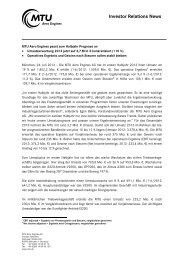
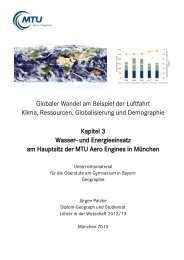
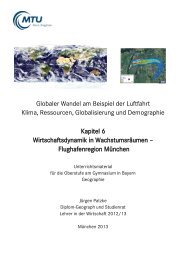
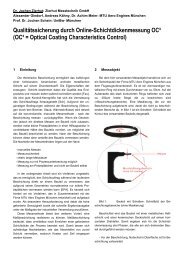
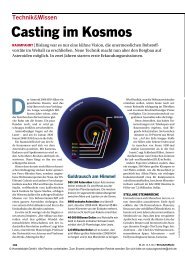

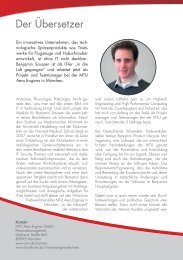
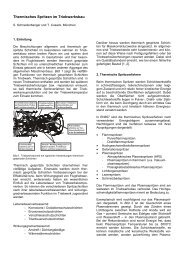
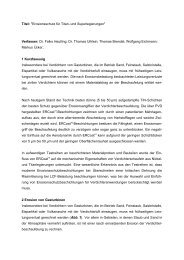


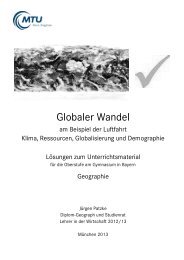
![Download PDF [5,37 MB] - MTU Aero Engines](https://img.yumpu.com/21945461/1/190x125/download-pdf-537-mb-mtu-aero-engines.jpg?quality=85)